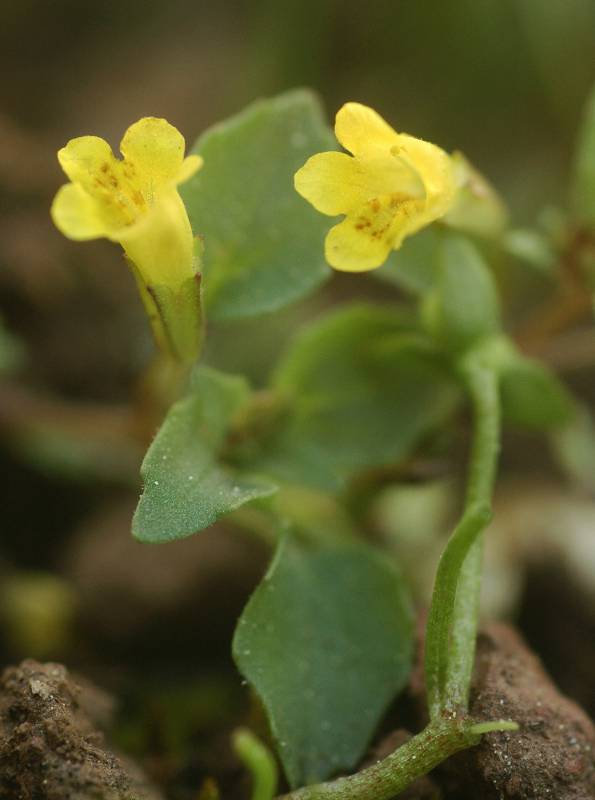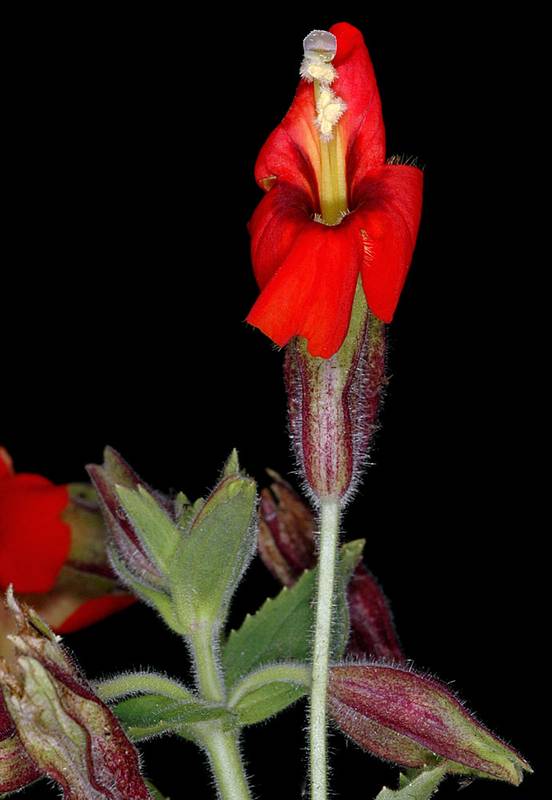Erythranthe patula
Erythranthe cardinalis
stalk-leaved monkey-flower
scarlet monkey-flower
Leaves cauline, basal ones not persistent;
petioles 8-25 mm;
blade deltate or somewhat ovate to lanceolate, approximately 4-12 mm long and 3-10 mm broad, palmate venation with 3 veins, base rounded to cuneate-truncate, margins usually finely toothed, apex acute to obtuse, surfaces glabrous as stems.
Leaves typically cauline; sessile;
blade ovate to elliptic to obovate, 20-90 mm long and 10-38 mm broad, palmate venation, base acuminate and nearly clasping, margins irregularly toothed, apex acute, surfaces hairy as stems.
Axillary flowers 1-10, emerging from nodes throughout; fruiting pedicels 10-25 mm, glandular as stems;
calyx tubular, barely or not inflated, 5-6 mm, margins with distinct teeth or lobes, slightly stipitate-glandular to sparsely hirtellous, lobes pronounced, erect;
corollas yellow, lower limb commonly with some red or brownish dots, symmetric radially or bilaterally, regular or weakly bilabiate;
tube-throat funnel-shaped, 7-8 mm, protruding beyond calyx margin;
lobes oblong, apex rounded to truncate;
styles glabrous;
anthers not protruding, glabrous.
Axillary flowers 2-12, emerging from leaf axes at mid- to ends of stem; fruiting pedicels generally 30-90 mm;
calyx cylindric to nearly bell-shaped, not inflated, 17-28 mm, hairy or bristly-hairy, lobes 4-7 mm, ovate to nearly deltate, apex attenuate-acute;
corollas red to orangish red or rarely yellow, throat yellowish with red stripes, palate red, yellow-villous and not spotted or striped, symmetric bilaterally, distinctly bilabiate;
tube-throat funnel-shaped, generally 20-30 mm, protruding beyond calyx margin;
throat open;
styles glabrous;
anthers protruding, white-hairy, thecae spreading.
Capsules 4-6 mm, included.
Capsules 10-16 mm, included.
Erythranthe patula
Erythranthe cardinalis
- Local floras:
BC,
OR,
WA
- Local Web sites:
Flora NW,
PNW Herbaria
WildflowerSearch
iNaturalist (observations)
- LBJ Wildflower Center
- SEINet
- Plants of the World Online
- Encyclopedia of Life
- Wikipedia
- Google Image Search
- Local floras:
CA,
OR,
WA
- Local Web sites:
CalFlora,
CalPhotos,
Flora NW,
PNW Herbaria
WildflowerSearch
iNaturalist (observations)
USDA Plants Database
- LBJ Wildflower Center
- SEINet
- Plants of the World Online
- Encyclopedia of Life
- Wikipedia
- Google Image Search



